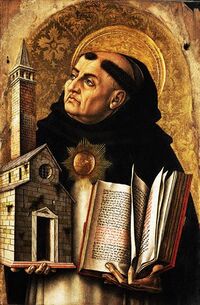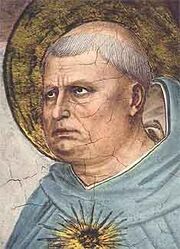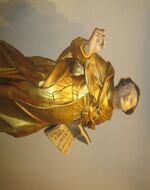Thomas Aquinas
| Western Philosophers Medieval Philosophy | |
|---|---|
| Tales about Thomas Aquinas are often exaggerated, saying that he is 400 feet tall and that his Summa Theologica weighs more than 5 whales. | |
| Name: Thomas Aquinas | |
| Birth: c. 1225 | |
| Death: 7 March 1274 | |
| School/tradition: Junior Scholasticism | |
| Main interests | |
| God, wearing fashionable robes, living with aquatic mammals | |
| Notable ideas | |
| I have a list proving God's existence | |
| Influences | Influenced |
| Aristotle | Dante and his merry trip through hell |
Thomas "Waterpants" Aquinas was an Italian Catholic priest, philosopher, theologian, head massage therapist, expert diver, and gourmet baker who did not die of the bubonic plague. The only other person who did not die of the plague was a street sweeper named Franklin. Some claim that Aquinas in fact was God himself, and purportedly there are eyewitness accounts of him turning urine into wine. Aquinas is considered the more important of the two by most water-dwelling species. He is the foremost proponent of natural theology, and father of the art of answering the call of nature (more specifically, the call of his seal cousins). Some of his contributions to theology included Scholasticism, or the practice of making flagrant and pretentious assumptions while using really big words in an era when few people could read (Frank was a school drop-out). He is held in the Roman Catholic Church as the model teacher for those studying to be like him but will never be as good as him. The work for which he is best known is the Summa Theologica (Latin for Theology Summed Up in Five Volumes of Two Thousand Pages Each[1][2]). He is considered by many Catholics to be the Church's greatest theologian, and won the award for "Shiniest Scalp" in 1270.
Biography
Early Life
Thomas Aquinas was born in, out, or around 122 AD at 6:14 AM on a Sunday in the maternity ward next the library in the castle atop a hill overlooking Roccasecca in the Kingdom of Naples. His father sold contraceptives was the noble Count Landulf and his mother was Theodora, Countess of Theate and Mistress of Great Curves who was related to the Holy Roman emperors through a deranged cousin. Landulf's brother Sinibad was a cleric who lived in the basement of the Benedictine Monastery at Monte Cassino where he housed all his smuggled wine and hosted his illegal gambling ring.
They had not invented disposable diapers back then and the family did not want to ruin their good white cloth with stinky brown stains that would never come off in the wash, so they wrapped up little Thomas in pages from the spare books that they held in the library's vault. However, Thomas had the habit to take off his paper diaper and read what was written on it. Consequently, he would end up pooping on the floor, but the constant reading led him to develop a college level reading skill at only 4 years of age.
At the age of 5 and shortly after being potty-trained, he was sent off to the Monastery for the Advanced Education of Little Geniuses. By the age of 16, he graduated at the top of his class and lost all the hair on the top of his head from male-pattern baldness. Over summer vacation, the Dominicans arrived in the village to enlist the ablest young scholars of the age for theological study. Since Thomas Aquinas was the smartest boy of the village[3] and looked most like a monk, they enlisted him. This did not suit well for his family, so his brothers captured Thomas, brought him back to their parents' castle, and locked him there for a year in order to make him renounce his aspirations for sainthood. They even brought in a stripper to tempt him into the world of sin, but he scared her away by saying that there were many other ways to express love rather than through the contact between a man's penis and a woman's vagina. Finally, the pope intervened, set Thomas free, and he took up the teaching of the Dominicans at age 7.
His superiors saw his great aptitude in the field of theology and were jealous that he was far smarter than any teacher there, so in late 12844, they gave Thomas a picnic basket and sent him 200000 miles over the yeti-infested Alps, across the part of the Danube populated by bridge trolls, and through the werewolf-filled Black Forest to the stinky after-shave city of Cologne in Germany, where friar and part-time A-list movie actor Albertus Magnus[4] was lecturing on philosophy and theology. In 1245, Thomas accompanied Albertus and walked another 2000 miles to the University of Paris[5] where they remained for the next three years. During this time, Thomas got involved in the massive flamewar between the university and the preachers over the right to teach. Aquinas actively resisted the university's speeches and pamphlets, saying that "it shalt be put to better use if thou shalt thrust them up thine hind quarters". When the pope was alerted of this flamewar which was now raging out of control, the Dominicans selected Aquinas to defend his honor in word combat. He did so with unprecedented success. He even overcame the arguments of Guillaume de St Amour, the champion debater and winner of 5 title matches.
Aquinas later graduated from the university with a bachelor's degree in theology with a minor in giving himself a head massage. In 12, he returned to Cologne and built himself a cozy little shack on university property.
Career
In 1252, Aquinas walked on his 2000-mile route back to Paris for his master's degree in philosophy/theological studies with a minor in bakery. He had some difficulty because the university was in short supply of cinnamon that was required for his end-of-semester soufflé, but ultimately, he received his degree.
In 1256, Aquinas, along with his friend and savior to abused and endangered animals Ace "Bona" Ventura, was named doctor of theology and head researcher in proving the existence of God, and began to lecture on theology to rich inner-city students in Paris and Rome. From this time on, his life was one of incessant blisters and athlete's foot. Aquinas continually served in his order with no paid overtime, frequently made long and tedious journeys with no restroom breaks, and constantly advised the reigning pontiff on what hat he should wear before going a night on the town. This problem was compounded even further as the pontiff had very bad taste in hats.
In 1259, Aquinas was selected to attend a board meeting at Valenciennes. At the request of Pope Hassan IV, he moved to Rome in late 1261, somewhere around Thanksgiving time. Just two years later, he had to walk 3000 miles to a Dominican meeting in London. This trip was somewhat extended, as Thomas lost his sense of direction and jogged around the Notre Dame about one hundred times before being reminded of where he was supposed to be going. In 1268, he lectured in Rome, then in Bologna. He didn't like staying in Bologna all that much, saying that it smelled too much like pig thighs.
From 1269 to 1271, Thomas traveled 2000 miles back to Paris for more work there. He lectured to mostly incompetent students (sometimes resorting to throwing things at them in order to get them to pay attention), managed the affairs and paperwork of the church, and answered the king, Louis VIII, whenever he asked if the robes he was wearing made his butt look big[6]. In 1272, the province chapter of Florence gave him the power to begin a new military general of study at a location of his choice[7]. Later, King Charles II called him back and had to make a walk 2000 miles back to Naples.
All this time, Aquinas preached and yelled at people every day, and he wrote lectures, homilies, disputations, arguments, and flamewars. He also worked diligently on his literary work, Summa Theologica, often writing ten pages in one hour. The church offered to make him both archbishop and abbot, but he refused both, the reason being that they were fed horribly.
As a Dominican Friar, he was supposed to participate in mortification; he did not, considering how devoted to his faith he was known to be. Whenever he arrived at the location where the mortification was being held, he would be off in his own little world in the corner of the room, moving his index finger on the walls as if writing an angry letter to the editor.[8] The witnesses who saw Thomas doing this praised him for his rational thought, and went off writing their own angry letters to the editors.
While celebrating Mass on December 6, 1273, Aquinas had a mystical experience, which was made evident by a tingling in his left arm followed by a seizure. At this point, he stopped working on his Summa. When asked why he did this, he replied "Gee, where do I start? I have rheumatoid arthritis in both my hands, my ass has sores from constant sitting, I keep experiencing prolonged migraines, I keep running out of ink, the bird sitting in the tree outside my window won't shut up, there's always a bad smell in here, there's always a fly in the soup they give me for lunch, they never remember to empty out the latrines, my bed is always itchy, and this damn cat won't leave my room! Also, I'm hungry. Are you going to eat that sandwich?" Later, witnesses reported that Aquinas heard a voice from a cross that told him he had written well, that his handwriting was neat and legible, and that his grammar was the best that God had ever seen. His Summa Theologica would later be published without his consent, and would become a best-seller in less than a year.
Aquinas had a dark complexion, a head so large you could land a plane on it, was balder than Patrick Stewart, and he was of large stature[9]. He always had an apathetic look on his face in family portraits, and was described by family and friends as "photogenic". In arguments and flamewars, he always kept a calm composure, which frustrated his opponents, and always won over the crowd with his personality, great intelligence, and a great impersonation of Fonzy. His tastes were simple; he ate plain bread, steaks with no sauce, and cereal without milk. He impressed his associates with his power of memory, but he never remembered to tie his shoes. When absorbed in thought, he would space off and begin to mumble, but strangely, he was still able to express his thoughts quite clearly. Because of his keen grasp of his materials, Aquinas does not make the reader his companion in the search for truth.[10] Rather, he teaches authoritatively, and makes the learner his bitch. On the other hand, he felt dissatisfied by the insufficiency of his works as compared to the divine revelations he had received, but whenever he tried to write down these revelations, he would begin to write into an indecipherable alphabet, possibly Cyrillic.
Death and canonization
On January 1274, Pope Gregory X ordered Aquinas to attend the Second Council of Lyons and to pick up some groceries afterwards. At first, Thomas refused, but after the Pope said that there would be cake there, he wholeheartedly agreed. Far from healthy due to his treadmill being broken with no one around that knew how to fix it, he undertook the journey of 2000 miles. On the way, he stopped at the castle of a sister of his for a spot of tea. There, a fly landed on his cup and he became seriously ill. Aquinas desired to end his days in a monastery. The people at the castle initially refused, but after Thomas threw a major hissy fit, the keepers agreed to take him to the nearest monastery they could find, which just happened to be right across the street next to the deli shop. Aquinas died on March 7, 1274. I lost track halfway through this article, but I believe that the total number of miles he walked in his lifetime was 16,074[11].
Just like Jesus Christ or Tupac, Thomas Aquinas received many awards long after his death. Shortly after his death, God proclaimed him angelus medicis caput et pes (head and foot doctor for angelic beings). Dante's Inferno, the first part of his Divine Comedy movie trilogy, was inspired by him sitting through one of Thomas' lectures during the summer time. Aquinas even made a cameo appearance in the third installment of The Divine Comedy movie trilogy, where he is shown having some wine with Saint Augustine.
Aquinas's Summa Theologica would go on to sell 250 million copies worldwide.[12] The Council of Trent considered his work so important that they made reading it mandatory in order to get a job as a clergyman.[13] In 1880, Aquinas was declared patron demigod of all Roman Catholic educational establishments. In a monastery in Naples, a cell in which he lived is still shown to visitors, and tourists can take a picture of themselves taking a dump in his personal latrine.
Legacy
Of all Aquinas's works, his List of Five Reasons Proving the Existence of God (and if It Does Not Prove the Existence of God, I Will Throw My Desk off a Cliff) is considered the most important. Below are the five reasons in all their original context:
- Reason 1:
- Something must have created the universe, therefore God created the universe.
- Reason 2:
- There is no reason 2.
- Reason 3:
- God declared that there was no reason 2 as a means to test your faith.
- Reason 4:
- Something must guide our bodies to do the things we all love (eat, drink, do the sideways tango); it is God that guides us.
- Reason 5:
- God commanded me to arrange the reasons for his existence into easily-mockable list form.
References
- ↑ Abridged title.
- ↑ Full title: Theology Summed Up in Five Volumes of Two Thousand Pages Each, Now On Sale for Only $159.99! Order Your Copy Today!
- ↑ To be truthful, he was the only boy in the village that knew how to read.
- ↑ His screen name was "Albert Magnum"
- ↑ Thomas spent most of the time walking around in circles following the path of a single bird
- ↑ The answer was always "yes".
- ↑ No one knows exactly where it was, but historians theorize that it was somewhere near a cheese maker.
- ↑ One of the letters he wrote on the wall said "Bring back Ziggy comics!"
- ↑ Thus creating the fable that he was 400 feet tall.
- ↑ Aquinas does not quite like companions.
- ↑ Give or take 2 furlongs.
- ↑ Most of them would be used as door stops.
- ↑ They didn't care how long it takes you to read it. Besides, reading is good for you.
| Featured version: 29 January 2008 | |
| This article has been featured on the main page. — You can vote for or nominate your favourite articles at Uncyclopedia:VFH. | |





